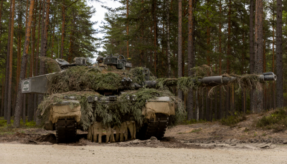
By Neil Fraser, Director Defence and Space Programmes, NSSLGlobal
In the last article, we explored the critical need for flexible and resilient tactical edge communications in the new era of multi-domain operations and the lessons learned from Ukraine. In this article, we will take a closer look into the diverse connectivity on land and how lessons from past conflicts have shaped current communication needs.
Diverse connectivity on land
While very different strategic, operational and tactical environments to Ukraine, the lessons from operations in Iraq and more notably in Afghanistan included the need for robust narrowband and broadband communications at the tactical edge. My own experience, albeit some time ago, of Afghanistan during tours in 2002, 2004/5 and 2008/9 showed the critical nature of satcom right at the edge, not simply for the traditional reach-back from large headquarters.
Company groups in Forward Operating Bases (FOBs) increasingly had access to networked IT systems, full motion video (FMV) from uncrewed platforms, tactical reach-back and networks such as TacSat and L-Tac services augmenting tactical or combat net radio systems. In reality, these networks took several years to roll out with the ebb and flow of bases and needs and included satellite and terrestrial solutions with significant infrastructure on the ground. The campaign in Afghanistan, over some 20 years, created expectations of being able to access these, and more improved services, but needing to do so in a more mobile and more challenged environment. The technology of both applications, augmented by AI/ML, and communications networks has moved on significantly and thus users at the edge should expect to be able to operate as well informed, if not better, than the best served headquarters of the past.
On land, smaller units can leverage handheld satellite connectivity and Push-to-Talk (PTT) systems alongside or instead of standard military radio systems. Tactical radio systems are constrained by range and terrain, requiring rebroadcast stations to match operational needs. Rebroadcast stations, whether crewed or uncrewed, however, are points of vulnerability when military systems demand low-latency connectivity over longer distances. Satellite based PTT networks can operate free of dependence on this infrastructure, with the flexibility to change coverage patterns and tactical groupings in minutes.
Small form satcom terminals with increasing bandwidth options can be integrated for resilience. These can be combined with the ability to switch to local networks, where available, or to connect small teams on combat radio or mobile ad-hoc networks (MANET). When one connection slows or fails, forces should not consciously have to make a decision to switch bearer or network. This must happen automatically with the ability to seamlessly switch between different types of secure connectivity or, indeed, remain on multiple networks simultaneously. Traffic should use the best available network depending on priority or throughput in a software-defined approach.
This all necessitates a focus on integration and the other acronym that pulls against PACE – which is SWaP (size, weight and power). More networks tends to mean more systems, more boxes and more power. When this is needed on the person, or on a vehicle or other platform, this presents a challenge. Industry can solve this problem, and noting that diversity of networks is needed, this is most likely to involve multiple providers. This balance of PACE and SWaP needs dialogue with end users and a greater understanding of their demands and threats and how to meet them, and in my view, this is where systems integrators play a key role across multiple suppliers and multiple, but often overlapping, use cases.
Meeting increasing data demands at sea
At sea, the evolution of command and control (C2) is moving towards the integration of data from numerous platforms such as airborne surveillance (both crewed and increasingly uncrewed), uncrewed surface vessels (USV), improved sensors and onboard systems. This necessitates real-time data exchange to provide situational awareness in the operational theatre, and co-ordinated action across fleets, aircraft and satellites. Similarly, the optimisation of onboard weapon, navigation and sensor systems all depends on real-time data exchange that is fully scalable.
With GEO connectivity unavailable in polar regions (which are strategically of increasing importance) maritime force elements need seamless switchover to current and future LEO services. These provide the necessary low-latency bandwidth in these difficult regions and their availability also provides resilience for interruption from attacks on GEO satellite services. In addition, Medium Earth Orbit (MEO) services are available and soon Highly Elliptical Orbit (HEO) services; all providing additional choice and resilience options for maritime capabilities.
The maritime domain also faces greater threats, and some of the response to that involves greater use of uncrewed and autonomous vessels, such as for mine hunting or other surveillance tasks. These vessels need to be able to sense and operate the same as crewed platforms, so again need resilient connectivity either to a mother ship, or a home base, to control operations; again, satcom plays a key role here.
A best-of-breed approach to the challenges in these regions will integrate the technology and overlapping coverage to ensure “always-on” connectivity in almost any location through secure and robust satcom. This runs across multiple bands, in multiple orbits and with integration with LTE networks, which forces can access in coastal regions.
Connectivity for air operations
The air domain is also becoming more complex and more challenged – with air superiority increasingly unlikely in many scenarios. Whilst looking back to the Cold War, in the 1990s, it seems we are returning to some degree to the way the Harrier Forces operated, from temporary and austere air bases. The UK, US and other nations are deploying forces for air policing into fairly remote bases, and also practicing more Agile Combat Employment (ACE) approaches. The key difference being that with modern aircraft systems, these temporary bases require high-bandwidth connectivity for mission planning and support applications
This again requires multiple satcom and other links to deliver resilience and also to connect the domains with a common operating picture and the ability to sense, decide and effect at pace. For example, the timely exchange of information between a reconnaissance aircraft and a vessel could enable the ship to optimise its countermeasures against an incoming threat. Or uncrewed platforms such as Loyal Wingmen or Protector Remotely Piloted Aircraft could cue other air activity, in defence or attack.
In summary
Combining experience from deployments, some of the stark lessons from the defence of Ukraine and the evident changes in both communications demands and the technology to meet those demands, it strikes me that many of the jigsaw pieces exist to deliver rich levels of information, at the tactical edge, over resilient networks combining satellite and terrestrial communications and meeting PACE and SWaP challenges. Not much needs to be invented, and in the short term this is not about deep Research and Development; albeit that is needed to ensure we can be ahead in future years. For now, what is needed is iterative integration activity to meet focused user demands and to test, refine, field and scale. Multi-domain integration and information dominance are key concepts in today’s defence thinking, but amount to little without the requisite connectivity to sense through crewed and uncrewed means; bring together information rapidly to decide, and then connect with the requisite forces or systems to deliver effect, and all at a faster pace against greater battlespace electronic and physical threats.







